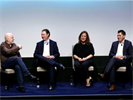Aarti Shah 02 Aug 2013 // 11:53PM GMT
DEARBORN, MI — Ford has redesigned its digital newsroom for the first time since the 90s, adding packaged narratives, shareable media and an internal dashboard that uses search traffic to shape editorial content.
“We want to increase the amount of storytelling for anyone who comes to the site,” said Sara Tatchio, manager of integrated global communications at Ford. The visually-driven site, however, retains some features for for accredited media, like certain PR contacts and customized slideshows.
It also features “collections” that package relevant content under six themes: green, safety, smart design, Ford’s history, Mustang and its suppliers. For instance, at launch this week the collections included stories on Ford using recycled plastic bottles in carpeting and 3D printing in manufacturing.
Ford, which partners with WPP for its marketing agencies, is also working with Ogilvy PR on an internal dashboard that aggregates commonly searched words about Ford from Google to determine knowledge gaps and interest areas for content, said Dirk Shaw, SVP at Ogilvy.
“The dashboard will be a key element driving our content factory,” said Tatchio.
The dashboard categorizes 32,000 keywords against Ford’s key pillars: green, safe and smart -- enabling the automaker to develop relevant content around these.
“If we notice people in the Northeast are really interested in plug-in hybrids, we can use this to inform our local media outreach and develop content,” Shaw said.
The dashboard moved data kept manually on a spreadsheet onto the automated, visual platform. Ogilvy developed the dashboard last year using a direct connection with Google’s API to index phrases against searches.
This technique, in some ways, measures the effectiveness of marketing because, in most instances, people won’t search for a specific brand unless prompted by campaigns -- whether paid, owned or earned, Shaw said.
“We give the 50,000-foot view to figure out how to get interest in Ford products and cultivate demand over time,” Shaw said. “Demand isn’t the law of gravity, it doesn’t just happen on its own.”
Each day, relevant buzzwords are tested against Google News. Buzz factor is determined by how many new pieces are connected to a word each day.
“You can see how effective PR is in not only producing content -- but in prompting others to write about Ford,” Shaw added.


































.jpg)

















